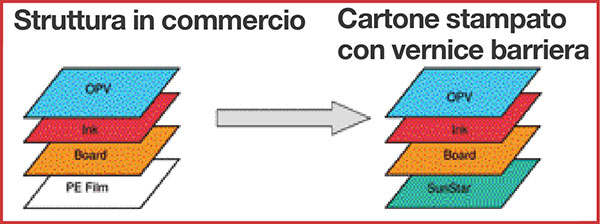InKitchen or cooking up new ideas
What do inks and the kitchen/cooking have in common ? The “K” of InKitchen, where Sun Chemical has organized “Cooking with you”, a “smart” event to present four lines of hi-tech, food contact barrier-varnishes. That enable the “lightening” of multilayer laminates, all to the advantage of the user, the consumer and the environment.

Everyone everywhere is subject to prevailing trends, and the kitchen and food preparation is no exception. People want to be slim and fit; packaging users demand ever lighter, thinner, more performant materials. And thus consumption habits change, with less sauce in our plates and less layers of packaging protecting that sauce.
Playing on the ideal affinity between “cooking up” food, inks and idea, and referring back to the basic theme that is food packaging, in Milan, last June 7th, Sun Chemical organized a true experiential marketing event. Gathered in a location with kitchen, some of the multinational’s customers plus a small group of sector journalists attended an up-beat, two voice presentation given by Paolo Caiani (SF + UV & Screen head) and Egidio Scotini (technical Head Inchiostri Liquidi), on the new food contact suited varnishes with barrier function. And they then tried their hand, under the guidance of a prestigious lady starry cook, in preparing the meal, which was then consumed together with a satisfaction multiplied by the direct involvement.. And if at a certain point the meal ended, the recollections remain, and the same goes for the varnish.
More barrier, less material
Protect the foodstuff from possible contamination, increase its shelf-life, simplify and lighten the packaging in order to - not least – reduce its environmental impact. These are the trends that dominate the global demand for food packaging materials. According to authoritative estimates, they will evermore condition the sector in the future, and users seem to be ready to pay the price, literally. The new barrier varnishes devised by Sun Chemical respond to these needs and they are set out in four products under the SunBar/SunStar brand, divided into function (the type of barrier ensured) and composition (water, solvent, mixed).

SunBar Barriera O2. A water and solvent based varnish, that ensures a better oxygen barrier compared to the three layer laminate with film. This varnish enables the attainment of two simpler and lighter (the weight is reduced by 30%) and consequently, less costly layers. On top of that, the multinational’s experts highlight, end of lifecycle handling of the pack is much simplified, while (no mean thing) material and material processing costs have been reduced.
The SunBar Barrier O2 can be used to obtain even more essential structures going from the laminate to the monofilm comprising only the polymer and barrier coating. As well as ensuring the advantages already seen this avoids the use of chlorine and adhesive while further lowering product costs, hence offering converters an even sharper competitive edge. Inside the company and with various printers Sun Chemical has carried out all the tests needed to document the performance of SunBar in the various structures (also on the subject of dry-curing, solvent retention…) and communicates another fact; compared to aluminium laminate, varnished films subjected to twisting present much fewer cracks and breakages.
UV SunBar Barrier. This is an innovatory solvent based varnish that protects foodstuffs from UV radiation. Its most evident pluspoint is that it enables production of entirely transparent as well as “windowed” packaging where, up to now, to protect the contents from UV radiation, colors or an aluminium layer were resorted to. Hence the way is open to product visibility without fear of degradation of the same and rather with an increase in shelf-life as for example in packs of cooked meat: stable to heat but sensitive to the effects of light and oxygen, whose contents when subjected to both phenomena tends to brown; SunbBar UV Barrier also solves this problem.
SunStar DFC for paper and cardboard. Developed, tested and used in several countries to eliminate the polythening of paper and paperboard, these coatings provide an easier and less expensive disposal of materials. These are water-based coatings suitable for food contact that, in addition to high barrier, have another set of fundamental characteristics: they are resistant to fats; they slow down vapor transmission rates (MVTR) allowing storage at low temperatures; they can be overprinted and glued; they can also be heatsealed.
SunStar DFC can be used by the printer just like an ink and without dedicated facilities. Its low viscosity makes it evenly spreadable over the entire surface of the material to be protected, thereby improving efficacy and appearance.
A series of recent applications on printed cardboard have documented the benefits: extrusion processes, the use of PVdC and chlorine are eliminated, giving a structure simpler to recycle and to achieve just in time (with material stocks reduced ...).

SunBar barrier mineral oils. Still under development, these coatings are designed with the future goal of also using printed recycled cardboard for food contact (more precisely they meet the mineral oil migration prerequisites governing recycled cardboard established by the German BfR).
The varnishes prevent, or at least significantly reduce, the migration of MOSH and MOAH (MOH) from the printed substrate to the packaging contents, similarly blocking hydrocarbons derived from mineral oils widely used, for example, in offset printing, and hence present in recovered paper.
The varnishes are applied to solid board (typically cartons of rice, pasta, cereals...) and corrugates (fruit trays, crates...) and in flowrap, overcoming the limits of existing barrier coatings.
And the inks?
Conditioned by the orientations of the big multinationals, the demand for low migration inks is also extending to sectors hitherto less sensitive to their advantages. Sun Chemicals responds by devising a new family of products for UV screen printing, that joins their already existing products Sunpak for conventional and SunCure and Sunbeam for UV/EB offset and Solarflex and Rayoflex for UV flexo.



















